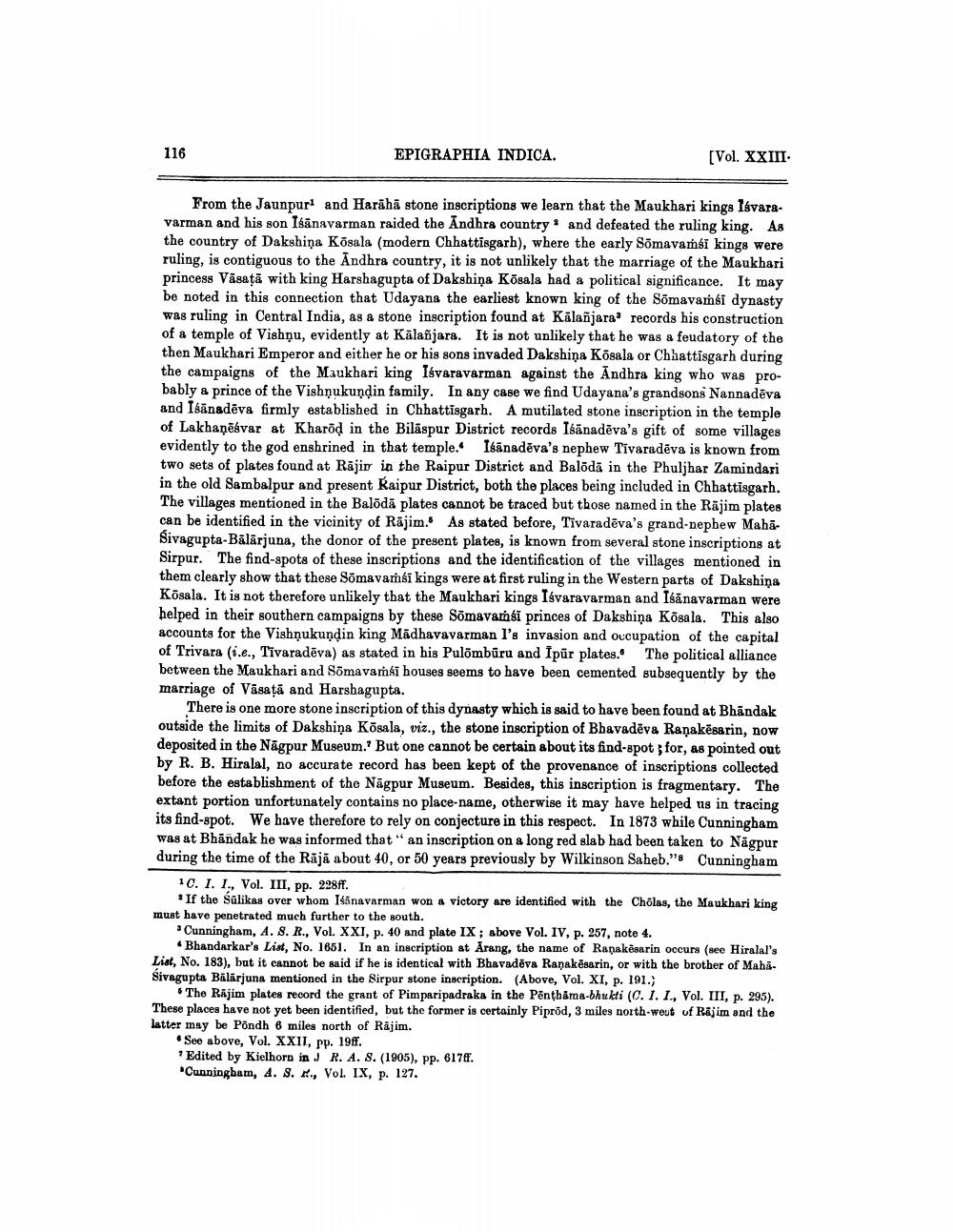________________
116
EPIGRAPHIA INDICA.
[Vol. XXIII.
From the Jaunpurl and Harāhā stone inscriptions we learn that the Maukhari kings Isvaravarman and his son Isänavarman raided the Andhra country and defeated the ruling king. As the country of Dakshina Kösala (modern Chhattisgarh), where the early Sõmavamsi kings were ruling, is contiguous to the Andhra country, it is not unlikely that the marriage of the Maukhari princess Vāsațā with king Harshagupta of Dakshiņa Kösala had a political significance. It may be noted in this connection that Udayana the earliest known king of the Sõmavami dynasty was ruling in Central India, as & stone inscription found at Kalañjara' records his construction of a temple of Vishņu, evidently at Kālañjara. It is not unlikely that he was a feudatory of the then Maukhari Emperor and either he or his sons invaded Dakshina Kösala or Chhattisgarh during the campaigns of the Maukhari king Isvaravarman against the Andhra king who was probably & prince of the Vishnukundin family. In any case we find Udayana's grandsons Nannadēva and Isänadēva firmly established in Chhattisgarh. A mutilated stone inscription in the temple of Lakhaņēsvar at Kharöd in the Bilaspur District records Isänadeva's gift of some villages evidently to the god enshrined in that temple. Isānadēva's nephew Tivaradēva is known from two sets of plates found at Räjir in the Raipur District and Baloda in the Phuljhar Zamindari in the old Sambalpur and present Raipur District, both the places being included in Chhattisgarh. The villages mentioned in the Balöda plates cannot be traced but those named in the Räjim plates can be identified in the vicinity of Räjim. As stated before, Tivaradēva's grand-nephew MabāSivagupta-Bālārjuna, the donor of the present plates, is known from several stone inscriptions at Sirpur. The find-spots of these inscriptions and the identification of the villages mentioned in them clearly show that these Sõmavamsi kings were at first ruling in the Western parts of Dakshina Kösala. It is not therefore unlikely that the Maukhari kings Isvaravarman and Isänavarman were helped in their southern campaigns by these Sõmavamsi princes of Dakshina Kõsala. This also accounts for the Vishņukundin king Madhavavarman l's invasion and oucupation of the capital of Trivara (i.e., Tivaradēva) as stated in his Pulõmburu and Ipür plates. The political alliance between the Maukhari and Sömavamsi houses seems to have been cemented subsequently by the marriage of Vāsaţă and Harshagupta.
There is one more stone inscription of this dynasty which is said to have been found at Bhandak outside the limits of Dakshiņa Kösala, viz., the stone inscription of Bhavadēva Raņakēsarin, now deposited in the Nagpur Museum.' But one cannot be certain about its find-spot ; for, as pointed out by R. B. Hiralal, no accurate record has been kept of the provenance of inscriptions collected before the establishment of the Nagpur Museum. Besides, this inscription is fragmentary. The extant portion unfortunately contains no place-name, otherwise it may have helped us in tracing its find-spot. We have therefore to rely on conjecture in this respect. In 1873 while Cunningham was at Bhandak he was informed that "an inscription on a long red slab had been taken to Nagpur during the time of the Räjä about 40, or 50 years previously by Wilkinson Saheb."8 Cunningham
10. I. I., Vol. III, pp. 228ff.
* If the Sülikas over whom Isanavarman won a victory are identified with the Cholas, the Maukhari king must have penetrated much further to the south.
Cunningham, A.S. R., Vol. XXI, p. 40 and plate IX ; above Vol. IV, p. 257, note 4.
Bhandarkar's List, No. 1651. In an inscription at Arang, the name of Ranakēsarin occurs (see Hiralal's List, No. 183), but it cannot be said if he is identical with Bhavadēva Ranakesarin, or with the brother of MahaSivagupta Bālārjuna mentioned in the Sirpur stone inscription. (Above, Vol. XI, p. 191.)
The RĀjim plates record the grant of Pimparipadraka in the Penthäma-bhukti (C. I. I., Vol. III, p. 295). These places have not yet been identified, but the former is certainly Pipröd, 3 miles north-weut of Rajim and the latter may be Põndh 6 miles north of Rajim.
. See above, Vol. XXII, pp. 19ff.
Edited by Kielhorn in J R. A. 8. (1905), pp. 617ff. *Cunningham, A. S. ., Vol. IX, p. 127.




